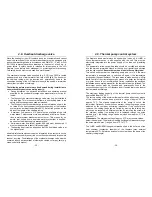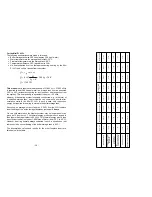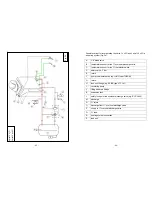
- 57 -
Risk of oxygen corrosion:
Constant presence of air in the fireplace insert is due to a leak in the
customer’s upstream pipework or incorrect positioning/dimensioning of the
expansion vessel (diaphragm expansion
vessel).
4. Operation
For operation, please refer also to the notes in the operating manual for
our fireplace insert. The notes in this installation and operating manual
relate to specific operation of a fireplace insert with integrated water heat
exchanger.
Generally speaking, the combustion chamber door must be used
as a door that closes automatically. The door may only be opened
to add firewood or, when cold, for cleaning. Tampering with the
closing device is not permitted.
CAUTION: The protective glove supplied is designed
only for protection from heat when operating the con-
trol handle and the cold hand. The glove is not fire-
proof!
There must be at least 80 cm between combustible compo-
nents/furniture and the glass!
The fireplace insert is designed for burning dry, natural firewood
with the bark still on, as well as wood briquettes. No other fuels
may be used
.
Operation partially fuelled will result in low flue gas temperatures.
This may lead to chimney damage if the H
2
O fireplace insert is
operated permanently with unsuitable chimney systems. For this
reason we recommend that the quantity of wood added per hour
during a day’s use does not drop below 2.0 kg.
The thermally actuated flue gas valve integrated in the heat ex-
changer of the H
2
O fireplace insert automatically controls opera-
tion of the latter. When the flue gas temperature is sufficiently high
(approx. 150°C), the flue gas valve closes automatically. This de-
flects the flue gas flow through the heat exchanger. When the flue
gas temperature falls below this temperature again, the flue gas
valve opens. For improved efficiency of the heat exchanger, the
- 58 -
H
2
O fireplace insert should be lit and stoked as evenly as possible
and the fire should not be allowed to subside to embers too often
if uniform heat discharge from the heat exchanger is to be en-
sured and low chimney temperatures avoided.
Double glazing (IR reflection): Infrared radiation from the combus-
tion chamber is largely reflected by the application of oxidic coat-
ings to the glass surface. These coatings generate a “Newton’s
Rings” phenomenon (similar to a rainbow), so-called IR reflection.
Due to this colouring, the characteristic feature of “IR reflection” is
visible and recognisable. This colouring cannot be removed.
The following conditions are required for operating the fireplace
insert at nominal heat output.
The fireplace insert has been heated up (the wood has already
been replenished 2-3 times).
Combustion must take place with the door closed.
Chimney draught: 12 Pa
14
Pa
(Varia Ah H
2
O and Varia A-Fdh H
2
O)
Wood: dry beech firewood; (moisture content < 18%)
Rate at which wood is added: see point 1.2
Air setting: Around the middle setting; depending on local
Conditions -
may need to be adjusted slightly (see example).
For a combustion period of approx. 60 minutes, see point 1.2
for the total output of the fireplace insert. Example of rate of
wood addition and air setting for the total output of the fireplace
insert.
Example of rate of wood addition and air setting
Summary of Contents for Mini Z1 H2O
Page 5: ...9 Mini Z1 H2O Fig 1a 10 Mini Z1 H2O XL Fig 1b...
Page 6: ...11 Mini Z1h H2O XL Fig 1c 12 Varia 1V H2O Fig 1d...
Page 7: ...13 Varia 1Vh H2O Fig 1e 14 Varia 1V H2O XL Fig 1f...
Page 8: ...15 Varia 1Vh H2O XL Fig 1g 16 Varia 1V H2O XXL Fig 1h...
Page 9: ...17 Varia 1Vh H2O XXL Fig 1i 18 Varia 2Lh 2Rh H2O Fig 1j...






































